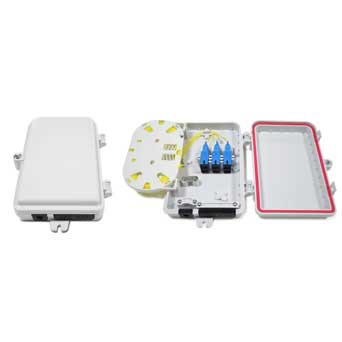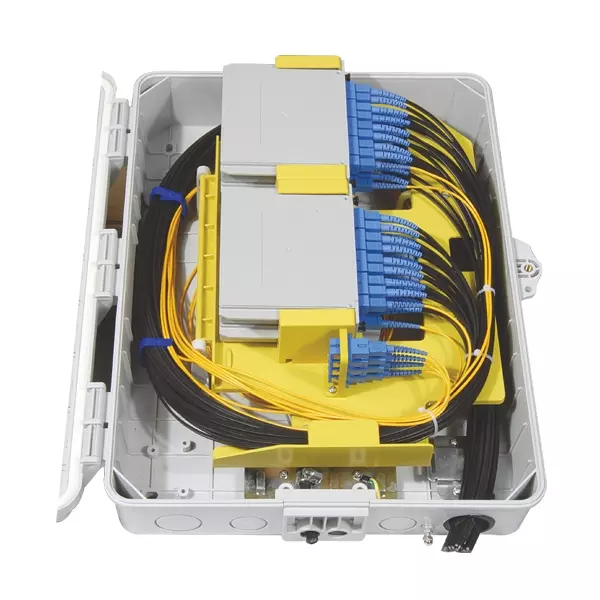Never Miss These Fiber Optic Terminal Box Features

In the realm of fiber optic networks, the significance of a fiber optic terminal box cannot be overstated. These compact yet vital devices play a crucial role in managing and terminating fiber optic cables, ensuring seamless connectivity. This blog will delve into key aspects such as cable-fixing efficiency, protective features, and optical performance. Understanding these features is paramount for maintaining efficient fiber optic networks and ensuring optimal functionality.
Essential Features
Cable-Fixing Efficiency
Efficient cable-fixing is a cornerstone of fiber optic terminal boxes, ensuring seamless connectivity within networks. It plays a vital role in the installation and maintenance processes, allowing for secure and stable connections. The fiber terminal box facilitates easy fixing, splicing, and mechanical protection of the fiber optic cables. With its user-friendly design and removable components, it simplifies troubleshooting tasks and reduces operational costs. Professional skills are recommended for installing the fiber optic indoor terminal box, given its technical nature. This box contains essential components like splice trays, adapters, and connectors to ensure proper alignment and protection of the fibers.
Protective Role
The protective function of the fiber optic terminal box is paramount in safeguarding delicate machinery. Through its design and materials, it shields the internal components from external elements that could disrupt operations. The box's robust construction enhances its durability, ensuring long-term protection for the fiber optics equipment housed within. By providing a secure environment for the fibers, it minimizes the risk of damage or signal interference.
Optical Performance
Optimal optical performance is a key requirement for fiber optic terminal boxes, necessitating low loss and minimal reflectance levels. These features are crucial for maintaining signal integrity and reducing data transmission errors. Mechanical strength is equally important to support consistent performance over time. By prioritizing these aspects in their design, fiber terminal boxes contribute to efficient network operations with minimal disruptions.
Simplicity of Connection
When it comes to fiber optic networks, the simplicity of connection offered by a Fiber Terminal Box is a game-changer. This feature emphasizes the ease of use and maintenance, catering to both novice users and seasoned professionals. The Fiber Terminal Box streamlines the connection process, allowing for quick and efficient setups without compromising quality. Its user-friendly design simplifies troubleshooting tasks, making it an ideal choice for various settings like FTTH (Fiber to the Home) installations or data centers.
In practical terms, this means that users can swiftly connect and manage fiber optic cables with minimal effort. The box's intuitive layout ensures that even complex connections can be established with ease, reducing the likelihood of errors during installation or maintenance. By saving time and minimizing potential mistakes, the Fiber Terminal Box enhances operational efficiency and overall network performance.
Whether you're setting up a new network or expanding an existing one, opting for a Fiber Terminal Box with a focus on simplicity can significantly streamline your connectivity processes.

Types of Connectors
Common Fiber Optic Connector Types
When it comes to fiber optic networks, understanding the various connector types is essential for seamless connectivity. Here are some common types:
SC Connectors:
Known for their push-pull coupling mechanism.
Ideal for high-density applications due to their square shape.
Offers low insertion loss and high return loss.
LC Connectors:
Feature a small form factor, making them popular for data centers.
Known for their easy handling and reliable performance.
Considered the most commonly used connector in data communications.
ST Connectors:
Utilizes a bayonet-style coupling mechanism.
Often used in networking environments like campuses and offices.
Provides good mechanical stability and durability.
Each of these connector types has its unique advantages, catering to different network requirements and setups.
MPO and MTP Connectors
In high-density applications where multiple fibers need to be connected, MPO (Multi-Fiber Push-On) and MTP (Multi-Fiber Termination Push-On) connectors play a crucial role:
MPO Connectors:
"Reduced time, cost, and specialized labor for extending cabling long distances to remote locations."
These connectors allow quick connections of multiple fibers simultaneously, reducing installation time significantly. They are commonly used in data centers and telecommunications networks.
MTP Connectors:
"Benefits of preconnectorized solutions in reducing labor costs and time for fiber deployments."
Similar to MPO connectors, MTP connectors offer high-density solutions with improved performance. They are known for their reliability in complex network architectures.
While these connectors enhance efficiency in high-density settings, it's important to consider both their advantages and potential limitations when selecting the most suitable option for your network infrastructure.
Single-Mode and Multimode Connectors
Differentiating between single-mode and multimode connectors is crucial for optimizing network performance:
Single-Mode Connectors:
Ideal for long-distance communication.
These connectors use a single transmission mode of light propagation, making them ideal for transmitting data over long distances with minimal signal loss.
Multimode Connectors:
Suitable for shorter distances within buildings or campuses.
With multiple transmission modes of light, multimode connectors are best suited for shorter reach applications where high bandwidth is required.
Understanding the specific applications of each connector type ensures that your network design aligns with the intended usage scenarios.

Considerations for Selection
Compatibility with Network Applications
When selecting a fiber optic terminal box, ensuring compatibility with network applications is paramount. The choice of the right fiber optic cable type is crucial to guarantee seamless connectivity and optimal performance. Different network setups may require specific cable types to accommodate varying data transmission needs. For instance, high-speed networks might benefit from Fiber cables designed for enhanced data transfer rates. Understanding the communication system's requirements helps in selecting the most suitable cable type for efficient data transmission.
Moreover, compatibility with network specifications is essential to ensure smooth operations within the network infrastructure. Adhering to specified standards and protocols guarantees interoperability and reduces potential connectivity issues. By aligning the fiber optic terminal box with network specifications, users can create a reliable and stable network environment that meets industry standards.
Environmental Factors
Environmental considerations play a significant role in determining the ideal terminal box for a given setting. Factors such as temperature variations, humidity levels, and exposure to external elements can impact the performance of fiber optic cables housed within the terminal box. It is essential to choose a box that can withstand these environmental challenges without compromising signal integrity or durability.
The maximum tensile rating of a fiber optic cable also holds significance in environmental settings. This rating indicates the maximum amount of pulling force the cable can endure before experiencing damage. Understanding this value helps in selecting an appropriate fiber optic terminal box that can support the cable's tensile strength requirements effectively.
In conclusion, fiber optic terminal boxes are indispensable for ensuring efficient fiber optic networks. By prioritizing features like cable-fixing efficiency, protective roles, and optical performance, users can guarantee seamless connectivity and optimal signal integrity. The selection process should consider compatibility with network applications and environmental factors to maintain reliability. Armed with this knowledge, readers can make informed decisions when choosing a fiber terminal box, enhancing network performance and longevity.
See Also
Discovering the Heart of ADSS Fiber Cable: Reliability, Efficiency, and Innovation
2024 Future Development Trends in Fiber Optic Industry
Exploring Singlemode and Multimode Fiber Optic Jumper Cables for FTTA & PTTA Networks
Understanding Preconnector and Fastconnect Technology in Fiber Optic Networks
Mastering SC and LC Fast Connectors for Fiber Optic Applications
About US
Follow Us
AnetFiber company's main products are indoor and outdoor optical fiber cables, outdoor waterproof pre-connected fiber-to-the-home products, PLC optical fiber splitters, optical fiber jumpers and pigtails, MTP®/MPO high-density big data product solutions, optical fiber field quick connectors and research and development molding, injection molding and production of optical fiber distribution boxes, optical fiber chassis cabinets, the market has expanded to the world, Europe, America, Asia, the Middle East and Latin America.
Address
Shenzhen City, Baoan District, Yanluo Street, Tangxiayong Community, Yangyong Industrial Road, Tonggangda New Energy Vehicle Park 406
Contacts
+86 199 2655 3586

